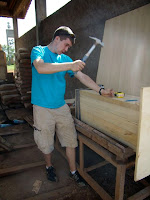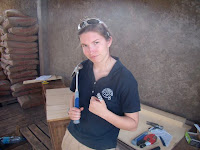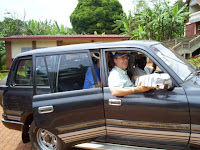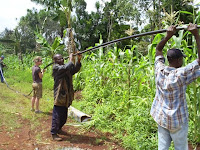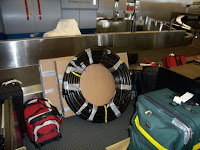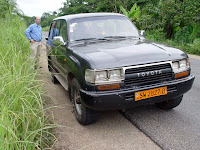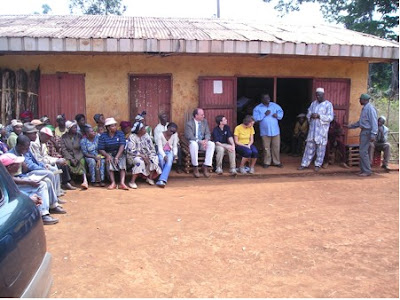Tuesday, June 17, 2008
Other notes
--Melissa
A final entry from Dr. Steve
I mentioned a few days ago that everything seems uphill here. One such Sisyphean effort is the battle against the reddish brown dirt and dust that blow and stick everywhere. Of course, it’s part of the fertile soil that supports the corn, beans, and potatoes grown here, but the dust, in particular, gives you a reddish collar, cuffs, and fingerprint within a short time outdoors. You can avoid having a brown tinge by frequent change of clothes, but when it rains, everything turns to a colorful mud that cannot be defeated. The mud adheres to shoes and gets tracked everywhere. Everyone takes off their shoes when going indoors, but this process seems to get mud on the bottom of your socks, too. Futility.
I am particularly aware of this as I now write, because we didn’t make it to Yaoundé in time to get our baggage yesterday. So all of us have been in the same change of clothes for 48 hours. My blue jeans are an interesting mix of tints from blue to dark brown that, frankly, looks very unprofessional. Note to parents: because these colors come from the ferric iron content of the soil, a laundry additive intended to remove iron stains *may* be successful in treating the clothes you will soon be staring at with some consternation. Bleach is less likely to work. The best solution may be to pack the clothes away until you go back to the High Plateau again.
So we're done and packing up. I have learned from my previous trips to
….Tuesday!! We had no internet in Bamendjou or Yaoundé and we are now in
And we’re also looking forward to being home!! See you soon!!
Saturday, June 14, 2008
Friday by Dr. Steve
Saturday – we’ve finished just about everything, and shipped most of our baggage to Yaoundé so that we can all fit in our vehicle, still tightly packed because we want to bring back some handicrafts to give to our supporting patrons! We feel great!
We’ll post again –
Dr. Steve
Thursday, June 12, 2008
Dr. steve on wednesday
Wednesday by Dr. Steve
We got a lot done on both projects today and morale is high. Tomorrow, when the sun shines, Bakang will have water, pumped from a depth of 150 feet using four solar panels and an electric submersible pump, and stored for use in a pair of 1,000 liter tanks. The hand pump that we’re replacing was broken again, so there had been no potable water at all.
I gave a presentation to the Water Committee yesterday on how the solar system works*, and I also explained the biosand filters. They were very interested in both, and asked some good questions. We also have a local NGO helping to orient the Water Committee on officers’ duties and financial aspects – I sat in on the first session and it was informative and oriented toward local issues. These people will be responsible for a lot, and they seem to take it seriously.
*I mean the solar-powered water system, not the Solar System. Thanks to
There are 40 families signed up for the bio-sand filters and we’re progressing well on that project, too. We built two of the concrete filter boxes while we learned the local materials, then had a local mason build another concrete form and pour the concrete while the Water Committee watched. We had some trouble with the diffuser system for the filter – that’s the part that keeps the water being poured in from disturbing the fragile biolayer on the sand surface. Metal screen didn’t work very well, but we found that local grain bags, made of woven plastic, work great when fastened to a framed screen. We’ve also sieved a lot of the local sand to put in the filters, and we’ll demonstrate that process on Friday. We’ve got people from an NGO in Youndé and from the
I am once again enjoying the incredible skills of Cameroonians. For example, the mold for our filter box is fairly complex, because we designed the interior mold as a set of boards that can be extracted stepwise and reused. When we showed the mason our mold, he understood the process almost instantly, even though we speak different languages. By the time we had been through the demonstration with him, we had seen several shortcuts on putting the thing together. We were using two-headed nails in some places to allow easy disassembly, but ran out…he immediately began bending the nails over a bit before they were all the way in, which provides good retention but easy extraction. I think he was impressed with us, though, because when he suggested we apply oil to the wood surfaces for easier dismantling, we already had the vegetable oil ready to go, and he really smiled. We were speaking the same language after all.
I should mention that this is an expensive trip. Many things are inexpensive, especially labor and some local foods (see below), but other things are not. The lumber, piping, and other building materials are more expensive than in the
Actually, here’s a rundown of some food prices from the expense list Martine gave me this morning. She’s Mr. Mukam’s sister and she’s been putting together our dinners with help from other family members. Since I love giving tests, it’s in the form of a very difficult matching quiz:
1. Avocadoes, 3-5, fresh and perfect
2. Carrots, 1 bunch
3. Greens (enough for 7 people)
4. Pineapple, yummy ripe
5. French bread
6. Chickens
7. Beef
8. Cooking oil
a. $0.65 a loaf
b. $1.25. This is something similar to kale or spinach.
c. About $9 apiece (free running, for sure)
d. $0.25
e. $3.10/lb
f. $1.20 apiece, not sliced. They’re not grown here, only at lower, more tropical elevations.
g. $2.50
h. $2.50 a qt. – seems to be used for everything
Answers, unless I got confused. Grade your own!
1-d
2-g (seems expensive – I’d better check on this)
3-b
4- f
5-a
6-c
7-e
8-h
That’s it for now. We’ve got a lot of sieving and sand washing to do.
Wednesday, June 11, 2008
Solar Adventures
Two days ago Gustav and Eric from the mission came out to Bakang to do the masonry for the tank supports and lay the footings for the solar rack. They did an amazing job and we were all impressed. We let them dry as we finished up the wire conduit connections and digging the trenches to lay the conduit. We've learned so much from this project and the people we are working with, its amazing. All thats left is to finish some of the connections and hook up the solar panels! :)
The slow sand team will post their progress soon...we're out of minutes on this computer right now...
Love and miss you all
i-team
Another Rookie's Account
The other day, after a long day of work, some children invited me to play football with them. Although I was unable to speak to them, I could communicate and connect with them through this game. It was also easy to communicate with the villagers. They patiently understood as we showed with pointing and other hand gestures.
Later today we will be hanging our solar panels and finishing burying the wires for the pump. I don't know what challenges we will face, but I am sure we can count on the villager's ingenuity and patience to help us overcome the problems.
Andrew
Monday, June 9, 2008
A Rookie's Perspective
I strongly believe that Cameroonians can do what ever they put their minds to. I know this because they are always trying to learn and understand whats going on around them. As soon as someone starts building or taking something apart, a crowd immediately surrounds them. Their problem solving skills are great too. Guy, our driver, was able to fix the Solar Team's boken blow torch after tinkering with it for a few minutes. He also fixed their generator with the help of a random villager who happened to be walking by when their generator failed. That is why I feel like the slow sand filters will really catch on in Bakang. The people will see how we make them and immediately learn how to do it themselves. They are so good at using the materials they have at hand to solve a problem. I know they will be able to continue to make these filters after we leave.
I can't wait to see how many great engineers will come out of Cameroon in the future with their new-found source of life: clean water.
Enjoying our borderless adventure
-Taylor
Saturday, June 7, 2008
Day 2 in Bakang and Bamendjou (by Dr. Steve)
The road is active with all kinds of foot and motorized traffic, even though it’s little more than a series of parallel ruts in the dirt. I haven’t kept track of the trip’s distance or the time to avoid getting impatient. The sad thing is that, except for the stretch in front of the brewery, the roads are no better once you arrive in the downtown area. The third largest city in Cameroon, it’s quite vibrant with small businesses and traffic congestion, and yet there’s simply no infrastructure.
We were able to find most of what we wanted, though. Plywood cut to order for a small fee…a gas generator at a reasonable price…PVC pipes…and some laundry detergent in envelopes so I can wash my socks. Also a butane torch and a crowbar, since these were not things we could take on an airplane, and bottled water since water is life. We also went to the water ministry and they helped us locate the well technician, who headed to Bakang on his moped. In the mean time, Nura helped the teams meet crucial people who were going to make cement blocks, move sand and gravel, supply and cut lumber. And later, we were all on site to see the hand pump get pulled out, and all the pipes that come up with it.
Today we started out with the Water Committee meeting. We had to walk there, doubletime, since the land cruiser wouldn’t start. Guy, the driver, later got someone from Bamendjou to help fix it (we met them going the other way on the mechanic’s moto). So we managed to get all our equipment to the sites after the Water Committee meeting.
Which was cool. Sarah and Sam wrote about it. I will just say that (1) the chief is eloquent and thoughtful, (2) explaining the concept of an election to the villagers took some doing; and (3) we now have an elected set of committee officers. They’ll have two orientation sessions next week, which we arranged for with the director of HydroSanté, a local NGO. The committee has also made arrangements for saving up funds for system maintenance already.
Later today, we had problems with the filter mold construction (a wrong measurement that meant a bit of deconstruction and reconstruction) but completed the mold at last, including steel reinforcement throughout, ready for the pouring. The solar team had problems because the pump tech had told us the well needed cleaning out, a big and expensive job. Thanks to Nura’s negotiating skills, we got them to do that today, but they gave up with the claim that the well wasn’t as deep as it was supposed to be … not true, according to our measurements. So the solar team will continue with a pump test tomorrow, while the filter team builds another filter box mold. Also, tomorrow is *Market Day* in Bamendjou, so we’ll do some shopping. We want to look for locally made crafts that might be sold in Delaware.
Notes from Dr. Steve
A difficult quiz for our readers on airport check-in procedures:
1. Chose the item below that does not belong in the tool bag (32 kg or 70 lb) when you check in your luggage:
a) hammer
b) crosscut saw, with blade teeth heavily masked with duct tape
c) Hostess Twinkies, a gift for Nura intended to be edible
d) an extra EWB team member
2. You have four-foot diameter roll of 1” poly pipe, 200 feet in length. At the check-in counter, the scale shows that it weighs 35.1 kg (77.2 lb). The attendant points out that the weight limit on any item is 32 kg. Your best action is:
a) cut off 18 feet of tubing, and also cut the excess into small pieces for Sam to stash in airport lobby trash cans
b) cut off 11.3 feet of tubing, and duct tape the excess to one of the oversize solar panel packages
c) cut off 182 feet of tubing and leave it in the airport garage to avoid $100 in excess baggage fees
d) cover the scale’s display with duct tape
e) tell the attendant that it’s carry-on.
Please post your selected answers or other suggestions for our proper protocol in the airport lobby. Or anything else . . .
On arriving in Bamendou...
What a beautiful country. As we drove up uphill onto the High Plateau toward Bamendjou, tropical treescapes lined the hillsides, silhouetted by the setting African sun. By the time we arrived at Mr. Mukam’s house, the skies were crystal black with stars and the Milky Way welcoming us. We could see them quite clearly . . . because there was a power outage. People got the backup generator cranked up even though the batteries had been stolen. Yes, it is indeed uphill, but we are here.
Friday, June 6, 2008
Bonsoir from Cameroon
As Melissa posted we made it successfully to the village, although it took about twice as long as it should have due to a flat tire and a late start. We had an unexpected lunch with Olivia's mother (Olivia is our main contact for the project) who whipped up a 3 course meal in about a half hour. We had forgotten that while we are here, we have to follow Cameroonian time, which means that everything takes at least twice as long, and lateness is accepted (patience is a virtue here). Even though the drive is 5 hours, time flies because of the beautiful scenery. Remind us to show you pictures when we return to the States. However, it is difficult to fully enjoy the scenery because your heart breaks every time you slow down to go through a village, and hundreds of adults and children come up to the car and try to sell you food or other goods, just to make 100 CFA (25 cents).
Since our arrival in the village we have been extremely busy. We're pulling about 16 hour days (don't worry moms and dads, we'll be fine, we still manage to have a lot of fun). Dinners are our time to unwind, and we'll just say, if you ever have a chance to meet the storyteller side of Dr. Steve, go for it. Dr. Steve is our entertainment for the trip.
Thursday both the filtration group (Sam, Julie, Taylor) and solar groups (Sarah, Doug, Andrew)travelled to nearby Bafoussam (3rd largest city in the 'roon) to buy materials for part of the day. The filtration group spent most of the day with Nura, the local Peace Corps volunteer who is AMAZING. With Nura, the filtration group walked around Bamendjou to locate wood, cement, sand, and gravel, and to coordinate logistics to the mission (our workspace). The solar group was able to locate the same well repairman we used last June, and he travelled to Bakang to remove the hand pump (which will be replaced with a submersible pump powered by solar panels).
It's amazing how helpful everyone is here. When we met with the director of water and mining in Bafoussam, it took two sentences before he was on the phone tracking down the well repair man. The filtration team asked for plywood to be cut in half to be easy to transport and instead, they cut it to our exact specifications.(saving us lots of time cutting by hand)
As return trip members(Julie and Sam), through working with Nura on this trip(who wasnt here last june) we have been able to be more interactive with the people here, which is a really neat experience. Everyone knows why we are here, as we have had people here on 3 different trips now) and they are so excited for the project to progress.
Moving on to today.... This morning we trecked to the mission, which is on the way to the village, with all of our hand tools(we have a lot) because the vehicle that we normally use decided not to start. (it has already been fixed though! hooray!) We then continued a 45 minute hike to the village to the water committee meeting at the chiefs compound and we truely felt like we were lifting the burden! The water committee meeting, while extremely long, went very well. A local NGO gave a presentation on how to organize a water committee and they helped organize the elections.... there is now a full board for the water committee that was democratically elected, including a woman treasurer! We are meeting with them again on tuesday for water education, more detailed decription of the project, and water committee training. They are extremely happy we are back and they are excited that our website has given a "name" to their village. They report that villagers who have made it to europe(not many) have communicated that Bakang is on the world wide web!!!!!!!
After the meeting we split back into our groups... Solar group clearing a space for the solar racking system and cleaned out the bottom of the bore hole well. The filtration team has completed our first wood mold and we are ready to pour the concrete in the morning. Tomorrow is market day in Bamendjou!!!!! We are excited to experience this and we may even join in a weekly soccer game!
We are storing a lot of our solar panels and equipment in the chiefs home in Bakang, as it is easier not to transport them everyday. When Dr. Steve dropped them off yesterday he apologized to the chief, for not letting him know ahead of time. And the response from the chief was astounding... he said not to worry, that we(EWB UD) have sacrificed so much for Bakang. Which is astounding to us, because we all feel that no matter how much time we spend on this project, we always seem to get so much more back.
We are excited for the next few days, as the project is really coming together. We will try hard to post again soon, but we are very busy.
As always we love and miss everyone back home!
Important note... this trip would not be possible without all of our dedicated design team members and the University of DE community!!!!!
I-Team (Dream Team)
Wednesday, June 4, 2008
Village arrival
-- Melissa
Monday, June 2, 2008
Nous Avons Les Betes! (oops...Nous Sommes...)
Our session with Peter Njodzeka was quite helpful. He's been working further north in Cameroon installing slow sand filters with the Hope College EWB. They report (1) nearly complete removal of bacteria, even from creek waters, and (2) significantly improved health with fewer illnesses reported. So we can anticipate similar success if all goes well in Bakang.
In Yaounde we are eating well. We ate a late lunch with our driver, Gui, at "Dolce Vita"... hamburgers, pizza, spaghetti, even ice cream! It was almost like being in America, except for that whole part where we had to order in french. In bamendjou our fare will be much more limited. For example, even Mr. Mukam's house has no refrigerator. Most cooking in homes uses an open fire.
We even finished our tasks a little early today, so we played a couple rounds of cards before a late dinner. Sam, card shark that she is, has taken everyones money and therefore the games have stopped. (just kidding!)
This is the first trip where we have 4 students returning to the 'roon, and only 2 newbies. The returning members are excited to show Taylor and Andrew the ropes. Taylor overslept a little this morning, but we will write this off as a rookie mistake. (hahah)
Thinking back to our previous trips, our crew seems less impacted by the crowds and conditions here. As a city Yaounde is in better shape than Douala and and most of us have already been through the initial culture shock. So far, anyway.....
Tomorrow we begin our journey to Bamendjou, where the real work begins. There are mixed emotions of excitement and nervousness here, as we are excited to finally implement but we are nervous because we understand what this new water system could mean for the community if it is effective.
Missing Everyone back in the states! Keep watching for blogs, but know that we will be very busy once we get to the village.
I-Team (Dream Team)
WE MADE IT
We made it to our hotel in Yaoude safely. Some interesting re-packaging went on at the Philly airport, but we finally got all our things on the plane. Its a tad humid, but our rooms have air conditioning so we are pretty comfortable. We're going to register with the Embassy tomorrow as well as meet with Dr. Nkang. Hope all is going well in the states!!
I-Team
June Implementation Trip
Wednesday, February 6, 2008
Post Trip Note
Saturday, February 2, 2008
-------------------------------------------------------
If anyone has been trying to follow the itinerary of our trip, then you will have quickly realized that we had to depart from it on many occasions. This trip has given us the opportunity to meet with many new people whose perspectives will surely help us make the best decisions possible. For an issue as important as potable water, we have learned not both sides to it, but at least a half dozen different viewpoints for the same goal. This trip has had its ups and downs, but for every failure we have seen, there have been clearly many more successful solutions in place.On Thursday we had finished talking with nearly everyone we had set out to contact. We decided to continue hiking through some of Bakang’s still unknown areas and discovered two new wells. The women who used them told us the familiar story that the wells were not used for drinking water. After taking pictures together with our digital cameras, I asked to take one more of them with my Polaroid. Giving them the slowly developing picture, it was a priceless moment to see their reaction when they realized they were looking at themselves. We could not understand what they were saying but they were very excited.
Our translator (Kom) teaches English at a local high school in Bamendjou and conversations with him turned to the teachers and facilities available there. Cameroon’s schools lack
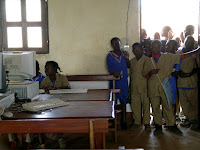 the number of teachers needed and the high school has about half as many as it needs. Kom and the local PCV Nura also teach basic computer skills to the students, but a computer lab full of 40 students must share between four well used computers. Nura has tried to use paper keyboards to teach the students but what they need are more computers. Compared to a potable water system, bringing several old computers by American standards to the high school seems to be a small challenge.
the number of teachers needed and the high school has about half as many as it needs. Kom and the local PCV Nura also teach basic computer skills to the students, but a computer lab full of 40 students must share between four well used computers. Nura has tried to use paper keyboards to teach the students but what they need are more computers. Compared to a potable water system, bringing several old computers by American standards to the high school seems to be a small challenge.After several last things to do in Yaoundé, we will shortly be heading home. This trip has been a great cultural experience and I look forward to sharing our adventures with everyone soon.
Doug
----------------------------------
We are coming to the end of our trip and it feels like we just got here. It is going to be such a drastic change to go from living in the village community where life just happens when it happens to a world where time and money tend to be the driving factors. Over breakfast this morning, I said how I feel like this is one of the first times in a long time where I have been truly relaxed, even though we have been constantly doing things. I have been thinking about the transition back into life at UD and I don’t feel that I will be ashamed for what I have, but rather grateful that I have the opportunities and the amenities to take advantage of these opportunities. It will be different though, not having every single person say “Bonjour” to you as you walk down the street. Life in this village is not easy, by our standards, but it is good. I am looking forward to sharing all of the experiences that I have had over these past few weeks with everyone and reflecting on the entire adventure.
We went to the “marché” yesterday which is the market in the village of Bamendjou. The traditional schedule includes an eight day week so the marché changes every week. There were countless numbers of tables every time you turned another corner. Everyone from the
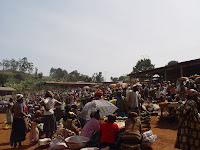
We are heading back to Yaoundé for the last night. We are planning on having dinner with a friend of Olivia, one of our contacts, and running a few last minute errands. Then it is to Paris and Philadelphia!
-Amelia
--------------------
We left the Bamiléké highlands today, for the capital city of Yaoundé and then home. This was my second trip and I expect several more, but still, leaving was with a touch of remorse. The people here expect so much of us and I hope we will live up to their expectations.
Of course, I will never know life here as they know it. But I have learned more of their traditions and the pride they have in their long history as a people. While keeping their traditions, they are ready for the changes that will bring them better health and a more prosperous life. Education is taken seriously in spite of the pitiable lack of resources in the schools. In the larger cities we have met an educated class that struggles with how to lift the standard of living for their population. I have heard many Cameroonians repeat a popular slogan that “nous sommes ensembles” – “we are together.” I reflect on the fact that, of the many hand-dug wells we surveyed in Bakang, not one was over 25 years old. This means that the most people grew up with their only water source being the streams. Change is accepted, but gradually.
The red dust blows in the dry winds, coating the igneous rocks from which it came. The dirt road takes us along valleys sprinkled with the traditional steep roofs now made of corrugated metal. The population density is high, so even the generous earth is hard pressed to provide for the people. We’ve eaten sumptuously, but primarily of the mainstay foods—plantains, greens, carrots, potatoes, corn—that provide a marginal level of protein. Electricity and potable water are luxuries and simply unavailable in more remote areas such as Bakang.
Word travels fast here without the need for electronics. Everyone who sees us on the roads and footpaths of Bakang knows who we are and what we’re working on. As we’ve passed people, one of the greetings we’ve heard is “bon courage.” They seem to know that we do not have an easy task. But none of them understand that we do not have the financial resources that we need—so far, at least—to engineer and construct their water system. We come from America, the land of wealth and generosity. The most educated of them imagine that we can write a note to Bill Gates for the funding we need. But, of course, it’s much more difficult than this.
I did not know that Engineers Without Borders would place us in this dilemma. As we fly out of Africa tomorrow, I will be wondering: Are we really “together?”
Dr. Steve
Wednesday, January 30, 2008
Tuesday - Jan 29th
Yes, another busy day and we have tons of information. I won’t go into all the details here, but we have many pages of notes.
First thing in the morning, we met with Marcel Fotim, the man from Hydrosanté. It’s a local NGO with a small office in Bamendjou. He
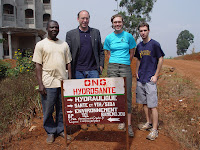 told us that they work for better water and health (santé) in the area. For example, there was a cholera outbreak here two years ago with a number of deaths. They conducted a survey and education campaign in that village, and he showed us the survey and their literature. They work as volunteers and don’t even have the funds to make as many copies as they would like to distribute. Marcel took us on a field trip of two water systems in a part of Bamendjou we have not seen before. First we saw a pretty s
told us that they work for better water and health (santé) in the area. For example, there was a cholera outbreak here two years ago with a number of deaths. They conducted a survey and education campaign in that village, and he showed us the survey and their literature. They work as volunteers and don’t even have the funds to make as many copies as they would like to distribute. Marcel took us on a field trip of two water systems in a part of Bamendjou we have not seen before. First we saw a pretty s izeable system put in by a Danish company, 15-20 years ago, with a gas-driven pump collecting creek water, a chlorination system, a large storage tank, and distribution to standpipes over a pretty large area. He said that the system only worked for a very short time because the villagers and chief did not reach agreement on how to pay for the necessary fuel. Everything still looked functional but the pump and motor had been removed. Then we hiked down to the creek and saw a system that diverted water down a long pipe to a ram pump, which sends some of the water further up the opposite rise to a monastery, where they apparently have a filtration system to clean the water. This setup is about 25 years old and functions well. It uses no fuel because the water pressure from the overall flow is used to send a fraction of the water to a higher elevation.
izeable system put in by a Danish company, 15-20 years ago, with a gas-driven pump collecting creek water, a chlorination system, a large storage tank, and distribution to standpipes over a pretty large area. He said that the system only worked for a very short time because the villagers and chief did not reach agreement on how to pay for the necessary fuel. Everything still looked functional but the pump and motor had been removed. Then we hiked down to the creek and saw a system that diverted water down a long pipe to a ram pump, which sends some of the water further up the opposite rise to a monastery, where they apparently have a filtration system to clean the water. This setup is about 25 years old and functions well. It uses no fuel because the water pressure from the overall flow is used to send a fraction of the water to a higher elevation.The contrast is stark and shows that any system we might install should consider very carefully what went wrong with the Danish system. The problem seems to have been that there was no institutional means of paying for fuel costs, rather than the level of technology, so one might think that a solar system would circumvent this. Still, the simplicity of the ram pump setup is appealing. So today we will look for elevation gradients near Bakang that would accommodate this. In general, we’re at a higher elevation where the flows may not suffice.
As if that was not enough to take in, we then went to Bafoussam to talk with the General Director of SNEC for the region. That’s the national water company. We had already seen that they have a water treatment plant between Bafoussam and Bamendjou. That’s where the water comes from that fills the storage tank in Bamendjou. The treatment plant was built by the French about 20 years ago. Our big question was whether this system could be extended to Bakang. There are really three questions: first, whether there is enough system capacity to serve the additional demand; second, what would be involved in getting the flow from existing lines out further to Bakang; and third, whether the water is affordable. The director said there was plenty of water, but we looked at the topo map together and the deep valley between Bamendjou and Bakang makes the extension somewhat challenging. He says the water price is affordable because it’s set by the government – we have heard differing opinions on this issue.
So that’s our learning for the day. We’ve had some random and funny experiences that Amelia promises to add to this! - Dr. Steve
Random observations from Amelia et al.:
· Probably, one of the strangest things that happened was while we were attempting to do the pump test. An old lady (the same one who danced with Sam during our last visit) came up to us, pulled a couple porcelain vials out of her purse while speaking Patois so we did not understand a word she said. She grabbed each of our LEFT hands and sprinkled a bit of ashes (of what we were not sure) and then mixed it with some dirt-like fine powder. Then she told us to lick up this concoction and she showed us how. Needless to say we passed up this wonderful opportunity.
· Another crazy story happened while we were in Bafoussam. We were just driving along trying to go visit a company and we came across a beer truck flipped on its side (how that happened we have no idea, but excess speed around the traffic circle is a likely cause). The people around this accident decided to help in the clean up and take some of the beer off of the truck. One man was standing on the sideways truck drinking his beer. This was even while the police were standing nearby!
· We have had some issues with the food we are eating. Martine is a well intentioned cook for us, but her repertoire seems limited. There are these reoccurring fish heads that seem to never die. The fish really isn’t to our liking but they seem to want to be with us for some reason and every meal includes a fish head looking at us.
· Our driver’s name is Guy (pronounced Gee) and he has the greatest ring tone that we have ever heard. It says “Ring Ring..Ring Ring..Your telephone is ringing” with a gradually increasing volume.
· My room is right by the gate that we are walking into the house in and there is a goat that lives right next to it. This animal has the most inconsistent sleep habits and it wakes up at all different times of the morning ( baaa …..baaaaa …….BAAAAAA………etc.). I never thought I would say that I am looking forward to sleeping in a bustling city but I think that I am.
· The other day we were going into Bafoussam and a log truck was stuck sideways in the road. To let drivers know that there is a problem up ahead, they place branches in the road. I guess it is an effective system. So there were cars and motorcycles backed up. Apparently the truck could not make it up the hill. After some discussion and whatever, they took the logs off the truck, dragged it back to the right direction, and pushed it up the hill. This was probably all the people from the bus that was waiting nearby. We don’t know if they came back for the logs…
· We are driving all over the place to talk to various people and our driver is really great about getting us where ever we need. The only issue we have is the music that we are listening to while we are going places. He has just a few CD’s that are (1) old country music, (2) instrumental American classics and (3) the evangelical Christian CD. While all of these could be good on there own, they tend to get really old after about four times. We bought him some new CD’s but he has made it clear that he prefers his own music. We paid 2500 CFA (about 5 bucks) for three CD’s but one only works on the computer, not his car CD player, and you get these odd music videos with it.
· There is this huge hole in the road on the way to Bafoussam. Basically, you really can’t see the bottom of it and your car will be lost in this hole. Along this road, I noticed a random sign that said “Danger de Mort” i.e. “Danger of Death”. Needless to say this has really caught our attention. The mayor claims that it is just an electrical plant, but the sign says “thermal generation.” We think that there is some sort of illegal testing going on there that they are trying to hide. We are going to try to find pictures of it on Google earth when we get back.
· Most people who live around here travel to various locations via bus. These are normal busses that you would find in the states and we all feel like we have been on one that is overcrowded with people and stuff. You have no idea how much you can fit on these busses. They pile people in (its so not safe) and then just keep putting stuff on top. They look like they are going to tip over as there is as the stuff on top is as high as the bus itself.
· Nura, the PCV, told us how she learned how to tie a string onto a cricket. She said that the little girls take their crickets for walks and the little boys are training them to fight with each other.
· We originally thought that many areas of Cameroon are booming with lots of construction, and scaffolding around buildings made of logs. But on closer inspection it becomes obvious that most of these projects were left unfinished in previous years. Nobody has the money to finish them or, for that matter, take down the scaffolding (let alone the structures themselves). Not so funny, just different.
Monday, January 28, 2008
January 27th
Last night at dinner we had some existential doubts about what we are doing and why. Hearing about the hardships shrugged off by the Peace Corps folks probably exacerbated this, but we also feel daunted by our own ambitious tasks. It can feel like the people of the Bakang village will live their lives whether we come here or not. Everything will always be covered with brown dust. There will always be ruts in the dirt roads and power lines with no electricity. The scope and degree of our differences can feel overwhelming, and what we will do here, no matter how successful, will be a drop in the bucket. Maybe only a droplet in the bucket.
I suppose, in our hesitations, we’re asking about this bucket, and why we would want to fill it. One might say that the volume needed is not the disparity between our cultures but between the levels of true need in our societies. And, in fact, our own bucket in the U.S. is hardly overflowing for some people. But on the average, at least (and that’s a big issue), I’d say it’s still pretty full.So how do we justify our work, when it can seem so negligible? One ethical test that one can apply to an action is to ask, “What would be the consequences if a lot more people did what I am going to do?” This makes me feel better about the droplet, because a lot of them together will fill a bucket. Lots of buckets. So, by this test, we’re doing the right thing.
But all in all, the bucket metaphor is still pretty limiting. For example, our chemical engineers know that it’s better to find a new catalyst than to build larger reactors. We want to help people bring out their own betterment. That’s what we do when we show people how to repair a well, or bring solar energy to a region that has not seen it before, but will adapt it to their needs.
Furthermore, the bucket analogy says we’re doing something that can be measured, and I am sure it *cannot* be. This is frustrating for an engineer! Of course we’ll be able to measure the water production from the wells we develop … but you can’t put a number on good will, and that’s an important part of this.
And besides, we may be engineers without borders, but we’re people without borders, too. What we do here is in the name of international good will, to show people who we are and that we share our capabilities. We’ll get them some cubic meters per hour of potable water…but we are also here to shake hands and share a smile, to root for the soccer team, to struggle with the language and hear them laugh, to walk down their roads with them. Those are immeasurables, but they’re the stuff going in the bucket. All of us in EWB are helping. Stop trying to measure it, and just do it the best way you can.
Okay, Dr. Steve – get some sleep.
1-27 – Dr. Steve
We were wondering if we’d have enough to do on Sunday, ha-ha. (please pardon any typos since I’m t
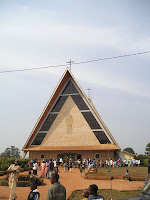 yping this on the laptop on a very bumpy road to Bafoussam!) – but it turned out to be loaded. We started out going to mass at the church on Mr. Mukam’s invitation and the service was quite different from what any of us are used to. This was the second service, which is in French and for the younger set; the early ser vice is in the local language for most of the locals. Singing was at least two thirds of the program and a wonderful mix of African traditional, Western hymns, and age-old Catholic chants. There was also a baptism included in the service.
yping this on the laptop on a very bumpy road to Bafoussam!) – but it turned out to be loaded. We started out going to mass at the church on Mr. Mukam’s invitation and the service was quite different from what any of us are used to. This was the second service, which is in French and for the younger set; the early ser vice is in the local language for most of the locals. Singing was at least two thirds of the program and a wonderful mix of African traditional, Western hymns, and age-old Catholic chants. There was also a baptism included in the service.For purposes of symmetry, Mr. Mukam then took us to funeral. But this was not like anything we’d ever seen before. The local chief (actually a sous-chef, subsidiary to the chief or King of all of Bafoussam) had passed away a number of months previously—and been buried—but it was now time for the big affair celebrating his life, and also choosing his successor. There was lots of food, and we were placed at a table with the mayor for a variety of hors d’oevres. W
 e left quickly, though, to get a view of the dancing as it began. There was traditional percussion and chanting by a central group while crowds formed lines that circled around the musicians. Apparently, when the music briefly stopped, a different part of the family would take over the music, and new groups of dancers would also crowd in. The daughters carried bags of the chief’s clothes on their heads, and there was a group of widows on the periphery who, per tradition, were holding empty pots. Since the mayor was asked to join the circling throngs, we followed as well and went around several times.
e left quickly, though, to get a view of the dancing as it began. There was traditional percussion and chanting by a central group while crowds formed lines that circled around the musicians. Apparently, when the music briefly stopped, a different part of the family would take over the music, and new groups of dancers would also crowd in. The daughters carried bags of the chief’s clothes on their heads, and there was a group of widows on the periphery who, per tradition, were holding empty pots. Since the mayor was asked to join the circling throngs, we followed as well and went around several times.Shortly after we exited the dancing circle, there was a great shout of excitement, and many of the people ran down a path through the crowd. Apparently, the new chief had been chosen – and captured - by the Notables. Here they came, to the music, with the new chief covered by a blanket, both preceded and followed in line by the Notables, some in bizarre masks and others in feathered disguise. They also circled the musicians. In the excitement, one person started firing a shotgun in the air, and we decided it was time to leave. But we got some unforgettable moments, with pictures and video to show you all!
Later that afternoon we really needed to get some work done, so we headed back to the Bakang area to scout out elevations and locations of the family compounds (called concéssions) near the school, well. and the hill as its crest runs away from the area. It was a very quiet hike but we ran across a family with a well higher up from where we had been before, which runs dry for 3-4 months of the dry season. One of the men spoke clear French so we learned a lot of the area and he walked us around to more wells and also another stream crossing which is a popular water collection point.
We got the same story we’ve heard before. Basically, the well water is turbid and its taste is
 bad, so most people only use it for washing. They go to the stream for their drinking water and don’t believe that it is harmful. So it seems like (a) education is in order, and (b) a means of treating the well water is needed. Of course, this is not what the water committee sees as the priorities. We’ve got a lot of work to do.
bad, so most people only use it for washing. They go to the stream for their drinking water and don’t believe that it is harmful. So it seems like (a) education is in order, and (b) a means of treating the well water is needed. Of course, this is not what the water committee sees as the priorities. We’ve got a lot of work to do.Today (Monday) we were going to start the well test early, but before we left the mayor’s house, a man from HydroSanté dropped by. His organization has an office in Bamendjou and we had a long discussion. We’ll meet with him tomorrow. We then proceeded to fail at our well test (we could not get the water level cable down the well, even though we were able to in our previous dry run, and we also cannot pump by had at more than 1.3 m3/hr, which we need), so we’re in Bafoussam to try some other things, like finding the well repair guy to help, and renting a pump. Hope for the best. We’ll update you soon!
Saturday, January 26, 2008
Well today has been an interesting day. We examined the hand pump and partially took it apart to make the water level meter could fit down the bore hole. The pump test will be on Monday and we all are looking forward to it. There were rumors of a local NGO called Acrest (www.acrest.org) using solar energy systems and with only a phone number we attempted to track them down this afternoon. We had partial directions when we left but then could not get through to our contact. After one wrong town we followed roadside directions to a place named Set. We instead came to a tea company and understood our English/French confusion. The NGO was located near the Cameroon Tea Estate (CTE) and had several projects in water usage. Unfortunately they were focused on using water to generate electricity and only had one small solar panel that they were experimenting with. It was still interesting place but it is funny how rumors can be generated. That is about all that has recently happened and I have just about had it with a French computer and an English keyboard. (The a,w,z,q, and m are not where they normally are.) Sorry about the pictures, we will try to upload them again.
Doug
Finally the last essential person arrived, the English teacher from the Bamendjou public school (lycée) who turned out to be an eloquent translator as we went through our five alternatives for potable water for Bakang. After the verbal descriptions and explanations, we brought out the poster, and the translator read it out loud.
The committee members then retreated to inside the small building to discuss the alternatives. The conversations were in the local patois, but we could tell from just outside that there were some heated discussions. When they came back out, everyone sat down again for the chief to announce their conclusion. He said that they had considered many parameters, and one that was important was that the housing compounds (concéssions), including the dug wells, were privately owned. This made the well retrofitting, and the rainwater catchments, more problematic.
The chief then said that they would prefer the alternative using solar panels. They understood that this was a more difficult project and it would take longer to accomplish. But he pointed out that food cooked rapidly on a hot fire was not as good as food cooked slowly and patiently. They also had agreed that each family would contribute financially to a fund to maintain the system. Finally, the chief asked that all present should announce their agreement to this decision, to show that it was not his voice alone that was speaking – and we heard all of the committee members in unison.
Before leaving, we agreed with the chief to meet and the mayor when he arrived that evening. We then went back to the mayor’s house to get our work gear and so Dr. Steve could take off his coat and tie. In the early afternoon we went out and inspected some more wells, but then got caught in a thunderstorm that seemed like it was not going to let up…so we bagged it and came back to the house to run the coliform analyses on our samples. To our dismay we seem to be missing our Petri dishes and the literature giving the dilution factors for the test. Sarah is e-mailing us the required information and points out that the bacterial tests are not as important as they were last time. We’ll look in Bafoussam today, but Petri dishes are not likely to be a stock item there!
After dinner, we hiked into Bamendjou where we met Nura and two other Peace Corps volunteers (PCVs). We picked up a beer each in a little store next to Nura’s little house, which is right across from the mission church, and then sat in her place and had a truly memorable conversation. The details we learned about life in Cameroon as a PCV would fill several blogs and these people are amazing, amazing, amazing. Also hilarious, because it seems like a strong sense of humor is an essential tool of survival for them. I’ll let Amelia and Doug share some of the PCV stories! We very much appreciate the fact that we are here for shorter periods of time and our accommodations are luxurious compared with theirs.
I’ll (Amelia) talk more about our time with the PCV’s. These people are so amazing! Nura talked about how lucky she is to have electricity in her house, but she is actually stealing it from the store just above her house with a little cord. She even has running water, but the shower is pointed directly at the toilet so she has to sit on it in order to take a shower. They are all starting a new project where they raise rats. Actually, it sounds disgusting but they assured us that rat meat is really good (not so sure about that). They are all going to be given three rats and have to breed them in order to sell them to people. What a career! Nura did assure us that the malaria pill that Doug and I are on is the best one that we could have, while Dr. Steve’s is not quite so lucky. There is a side effect of sun sensitivity and Dr. Steve’s head is now a bit pink even though we haven’t had much sun (he has a solar collector)! They are all on the pill with night terrors and are having some interesting dreams it sounds like. It was so nice to see them for a while and after we came to Mr. Mukam’s house to watch the football game with the chief of Bakang II and another chief from the area (it was Mali versus Nigeria). Going backwards in time, on Thursday, after we were able to blog for a while in the internet café in Baffousan, we went around the city trying to find products that would be applicable during an implementation phase. Luckily, we found a man in a store who was able to show us another store that would be able to help us. Unlike in the US, the idea of competition seems not to exist. This man took us to another store separate from his in order to help us find what we were looking for. The same occurred when we were trying to exchange our money at the bank; the first bank gave us a quote but told us we could get a better rate some place else. Needless to say, we went to the other location. Otherwise, things seem to be going well. Hopefully it won’t rain so that we will be able to look at all the wells and housing locations in the village.
-Amelia
Thursday, January 24, 2008


It has been a hectic past few days with hours of traveling and many meetings, but we now have a chance to talk about our trip thus far. Our flights were safe and uneventful; we only had a brief delay when a tire had low pressure. We had a two hour layover in Paris and touched down in Douala before arriving in Yaoundé. It was easily apparent why frequent travelers to Cameroon prefer Yaoundé airport over Douala. The facilities were well kept and the weather tends to be cooler and less humid. After Mayor Mukam greeted us on our arrival, we were driven to the Hôtel le Tango. Despite not being in either of our travel guides, the accommodations have been quite nice with “air conditioning” and a curious set of stairwells. Our rooms were on the first floor but getting to them involved several flights of steps and turns that are impossible to navigate in the dark.
Bafoussam
Doug
Tuesday, January 22, 2008
Yaoundé Update
We have all made it safely and are traveling around Yaoundé today. We dropped quickly into an internet cafe but we are off again to meet a well driller contact we previously emailed. Tomorrow we will meet at the US embassy to discuss possible resource opportunities for our project. We will be able to talk more later and upload some pictures.
Doug
In Cameroon
Things are going very well. We met with Dr. Nkeng today and we are going to go back in a few min to talk to one of the well drillers that gave the quote. We tried to go to the embassy this morning, but we did not have an appointment. We were able to get one for the, morning so we can go there before we leave for the village. The hotel that we are in is good and we are doing well. Dr Steve almost lost his ticket in Paris which could have been a bit of a problem. Hopefully we will post soon again with pictures.
Amelia
